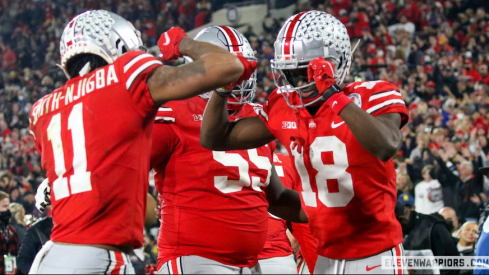
Given the season, I interrupt my usual football breakdowns to take a look at the Ohio State basketball team.
Basketball is one sport where a discernible conflict can exist between the interests of the individual and the team. As Michael Lewis writes, baseball is essentially an individual sport within a team game. With football, play calling is generally controlled by coaches, and with 11 players any single player is highly dependent on one another.
In basketball, however, a player has sufficient freedom and control that tension between the individual and team's goals can arise. Basketball has traditionally measured and easily traceable statistics, such as shots and points. But merely because one player scores more points does not mean those additional points are marginally beneficial to the team.
As Lewis continues:
Taking a bad shot when you don’t need to is only the most obvious example. A point guard might selfishly give up an open shot for an assist. You can see it happen every night, when he’s racing down court for an open layup, and instead of taking it, he passes it back to a trailing teammate. The teammate usually finishes with some sensational dunk, but the likelihood of scoring nevertheless declined. “The marginal assist is worth more money to the point guard than the marginal point,” Morey says. Blocked shots — they look great, but unless you secure the ball afterward, you haven’t helped your team all that much . . .
Basketball analysts thus sought some metric that would measure team contribution rather than individual success.
Enter the plus/minus metric.
Plus/minus simply measures a team's point differential when a player is on the floor as opposed to the bench. At its best, plus/minus simply creates an individual statistic that measures an individual's overall impact upon the team outcome. The goal is to measure the not easily discernible contributions and disentangle the potential conflict that exists between individual performance and team outcomes.
Plus/minus is not without its flaws. The most obvious example is that a player's plus/minus can artificially be raised by a teammate's contribution. Nevertheless, it is at least a rough attempt to measure a player's overall team contribution without focusing on individual metrics.
The Paradox of the 2012 Buckeyes Basketball Team
Ohio State has won its last 10 games. In so doing it has risen to fifth in Ken Pom's rankings and, according Nate Silver, has a 40% chance to reach the Final Four. And yet the plus/minus statistics indicate that OSU may be operating suboptimally. In particular, the Buckeyes' starting lineup is clearly not their best grouping.
Here are the Buckeyes' plus/minus numbers from the streak:
| Player | minutes | plus/minus |
|---|---|---|
| Craft | 35.9 | +13.8 |
| Smith | 25.4 | +3.9 |
| Thompson | 25.9 | +10.4 |
| Thomas | 35.8 | +11.8 |
| Williams | 15.3 | +2.2 |
| Scott | 24.1 | +12.3 |
| Ravenel | 16.4 | +5.4 |
| Ross | 15.1 | +4.8 |
As can be seen, Ohio State's starting lineup contains two of the lower plus/minus totals of the players in its rotation in Amir Williams and Lenzelle Smith. Shannon Scott is playing effectively the same minutes as Smith and Sam Thompson. Yet Scott's plus/minus is two points above Thompson's and nearly triple Smith's. Indeed, OSU's winning streak coincides with a sustained uptick in Scott's minutes.
This is also noticeable on the floor. Scott's defensive effectiveness (particularly when combined with Craft) in addition to his passing ability, which allows Craft to play off the ball and become more of a scorer, and ability to push tempo for easy baskets, have been an instrumental factor in the Buckeyes' run. The Iowa State game only reinforced this trend, with Scott finishing with +8 and Smith at -7. LaQuinton Ross' plus/minus has also improved over the last 5 games, and his +9 against Iowa Stat was crucial to securing the victory.
This suggests that the Buckeyes are not maximizing their potential output. Granted, OSU has limited options inside. Williams' plus/minus is low, but Evan Ravenel does not offer a significant upgrade. This does underscore, however, that OSU should play its 'small lineup' as frequently as possible. OSU likely did not utilize this combination enough against Iowa State, given that it produced the highest plus/minus.
But the biggest takeaway is that even with additional minutes, Scott is being underutilized. The Buckeye with the second-highest plus/minus is averaging approximately 11 minutes less than Aaron Craft and Deshaun Thomas, the only Buckeyes with comparable ratios. The concern is those lost minutes will cost OSU as the competition stiffens. Indeed, the 15-point differential between Scott and Smith against Iowa State alone could have sidelined OSU.
Do you Mess with a good thing?
Thad Matta and his staff are assuredly aware of their players' relative effectiveness. OSU's lineup to end games is very different from the one that starts. It generally features Scott with Craft, Thomas, and two of the three of Thompson, Smith, and Ross if OSU is able to go small. Yet this gets to the concern — if the coaching staff also recognizes this as the Buckeyes' best lineup, are they performing at a submaximal level by failing to employ those players more frequently?
Other considerations are certainly at play for Matta. OSU is 10-0 with its current starting lineup. As Scoonie Penn and others have essentially said, if it ain't broke, don't fix it. There are also internal dynamics to consider. Smith is a two-year starter. Matta must balance team chemistry and does not want to impede the team's upward trajectory.
Yet the purpose of plus/minus is to attempt to capture such intangibles. And better maximizing the Buckeyes' plus/minus can be done at the margins without wholesale changes. As noted, one such change would be playing its small lineup whenever possible. This allows both Scott and Ross to be on the floor and without Ross being forced to play the 3. Ohio State may not be able to employ this line-up tonight against Arizona with Freshman Center Kaleb Tarczewski. As noted by Andy Glockner, though, OSU should implement this look whenever the Wildcats' 7-footer is not on the floor. And Glockner notes that OSU could also employ this line-up with Tarczewski in to create mismatches.
Short of that, OSU seemingly needs to free up more minutes for Scott. He does not need to start to do so. Simply bringing him in immediately after the under-16 minute timeout could elevate his playing time closer to 30 minutes. Such a substitution pattern could better allow OSU to utilize those who have been playing most effectively.

